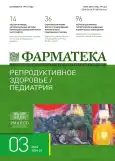Neuroendocrine hyperplasia of infants: clinical observation
- Authors: Ivanova D.K.1, Aleksandrova T.V.1, Smetanina Y.O.1, Emeeva Z.Y.1, Sergienko D.F.1, Ilyenkova N.A.1
-
Affiliations:
- Astrakhan State Medical University
- Issue: Vol 31, No 3 (2024)
- Pages: 96-100
- Section: Clinical case
- URL: https://journals.rcsi.science/2073-4034/article/view/262441
- DOI: https://doi.org/10.18565/pharmateca.2024.3.96-100
- ID: 262441
Cite item
Abstract
Tremendous progress has now been made in studying the etiopathogenesis of interstitial lung disease in children, with an understanding of how interstitial lung disease (ILD) in infants differs from the forms that occur in older children and adults. Diagnosis is difficult due to the rarity of diseases of this nosological group and the similarity of symptoms with other common respiratory diseases. Neuroendocrine cell hyperplasia of infancy (NEHI) today refers to diseases with a poorly understood etiology, but with a characteristic symptom complex and picture during diagnostic imaging. According to the literature, the prevalence of the disease has been little studied, because only individual cases are described. The disease is described in children of the first years of life and is characterized by constant tachypnea, slight hypoxemia, crepitus on auscultation of the lungs and a decrease in the rate of physical development. In the past, invasive diagnostic methods in the form of thoracoscopic lung biopsy were necessary to confirm the diagnosis, but now, due to accumulated experience and the description of characteristic changes on computed tomography in the form of a “mosaic perfusion” pattern involving at least 4 segments with a predominance in the projection of the middle lobe of the right and lingular segments of the left lung in combination with a characteristic symptom complex, does not require invasive research methods. Understanding the mechanisms of NEHI dictates a gentle tactics for administering the patient without the active use of therapy with systemic and inhaled glucocorticosteroids. At the same time, despite the described favorable prognosis of the disease, this nosological form remains poorly studied, and patients require special monitoring and long-term examination, because the effects on children’s health and pulmonary function in later life have not yet been described. The article presents a clinical case of diagnosis and follow-up of a child with NEHI, who was examined at the Pediatric Department of the N.N.Silishcheva Reginal Children’s Clinical Hospital, Astrakhan.
Full Text
##article.viewOnOriginalSite##About the authors
D. K. Ivanova
Astrakhan State Medical University
Email: gazken@rambler.ru
Russian Federation, Astrakhan
T. V. Aleksandrova
Astrakhan State Medical University
Email: gazken@rambler.ru
ORCID iD: 0000-0002-8529-1841
Russian Federation, Astrakhan
Ya. O. Smetanina
Astrakhan State Medical University
Email: gazken@rambler.ru
Russian Federation, Astrakhan
Z. Y. Emeeva
Astrakhan State Medical University
Email: gazken@rambler.ru
Russian Federation, Astrakhan
Diana F. Sergienko
Astrakhan State Medical University
Author for correspondence.
Email: gazken@rambler.ru
ORCID iD: 0000-0002-0875-6780
Dr. Sci. (Med.), Professor of the Department of Faculty Pediatrics
Russian Federation, AstrakhanN. A. Ilyenkova
Astrakhan State Medical University
Email: gazken@rambler.ru
ORCID iD: 0000-0001-8058-7806
Russian Federation, Astrakhan
References
- Овсянников Д.Ю., Беляшова М.А., Бойцова Е.В. и др. Нозологическая структура и особенности интерстициальных заболеваний легких у детей первых 2 лет жизни: результаты многоцентрового исследования. Неонатология: новости, мнения, обучение. 2018;6:93–104. [Ovsyannikov D.Yu., Belyashova M.A., Boytsova E.V., et al. Nosological structure and features of interstitial lung diseases in children in the first 2 years of life: results of a multicenter study. Neonatology: news, opinions, training. 2018;6:93–104. (In Russ.)]. doi: 10.24411/2308-2402-2018-00022.
- Langer F., Werlein C., Soudah B., et al. Interstitial lung disease in infancy and early childhood. Pathologe. 2021;42(1):25–34. doi: 10.1007/s00292-020-00884-8.
- Mastej E.J., DeBoer E.M., Humphries S.M., et al. Lung and airway shape in neuroen-docrine cell hyperplasia of infancy. Pediatr Radiol. 2018;48:1745–54. doi: 10.1007/s00247-018-4189-6.
- Cinel G., Kiper N., Orhan D., et al. Childhood diffuse parenchymal lung diseases: We need a new classification. Clin Respir J. 2020;14(2):102–8. doi: 10.1111/crj.13106.
- Griese M. Etiologic classification of diffuse parenchymal (inter-stitial) lung diseases. J Clin Med. 2022;11(6):1747. doi: 10.3390/jcm11061747.
Supplementary files









